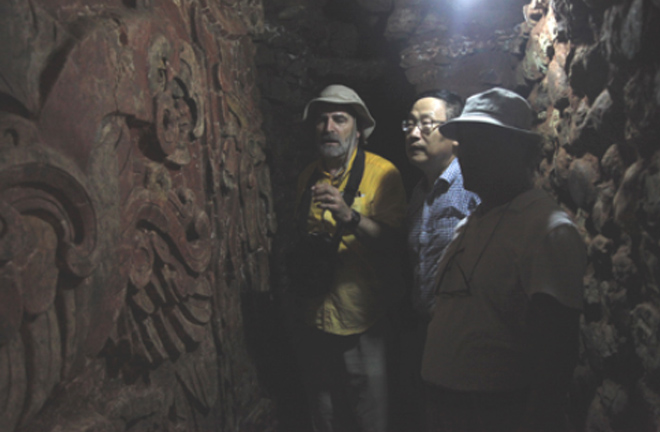Chinese, Honduran academics ink five-year archaeology deal

Wang Wei, head of the Institute of Archaeology at the Chinese Academy of Social Sciences, listen to William Fash, dean of the Anthropology Department at Harvard University, introducing the internal structure of the pyramid at the Copan site.
Chinese and Honduran academics have signed a five-year deal to jointly explore and research Copán, a Mayan archaeological site in western Honduras. The agreement was inked by the Institute of Archaeology (IA) at the Chinese Academy of Social Sciences (CASS) and the Honduran Institute of Anthropology and History (Instituto Hondureño de Antropología e Historia, IHAH) on June 9 in Beijing.
Under the agreement, the IA will dispatch a team of archaeologists to carry out excavations and studies of the Copán site. The Honduran side has committed significant support to the project, regarding it as a key milestone in collaboration between the two countries and ancient civilizations.
“I believe China will contribute new methodologies, techniques and ideas and promote common understanding of our civilization. I also believe that through cooperation, I can recognize more deeply that the Chinese and Mayan civilizations might have been relatives of each other in the past,” said Virgilio Paredes Trapero, director of the IHAH.
The project is being led by Wang Wei, CASS Member and head of the IA. In July 2014, Wang led a three-member delegation on a five-day tour of the Copán site with the help of William Fash, dean of the Anthropology Department at Harvard University, and reached an intentional cooperation framework agreement with the IHAH.
From the fifth to eighth centuries, Copán was one of the most important sites of the Mayan civilization. Many carvings, artworks and textual records have been unearthed from the site that includes pyramid temples, tombs and royal palaces.
Enjoying a pivotal position in Mayan studies, Copán is reputed as the cradle and holy land of the Mayan culture. In 1980, it was declared a UNESCO World Heritage Site.
From July to October, the Chinese and Honduran sides will jointly conduct their first excavation and multidisciplinary research of the Group 8N-11, an aristocratic compound. Covering an area of approximately 6,000 square meters, the compound comprises a closed courtyard surrounded by auxiliary buildings. Its status was next only to the royal palace.
In 1990, an archaeological team from the University of Pennsylvania explored the eastern part of the building complex. In the main room central to the eastern compound, they discovered stone couches with carved patterns of sun, moon and star gods. The discovery indicated that its resident might be among the upper nobility and interested in astronomy, providing clues to the political system and power structure of ancient Copán.
Li Xinwei, an IA research fellow responsible for excavation in the project, said various remains unearthed from the compound are of tremendous value to studying the development and evolution of the Copán site. The project will excavate other parts of the building complex. Carvings and textual records are expected to be found to deepen researchers’ understanding of the compound, Li added.
Zhang Chunhai is a reporter at the Chinese Social Sciences Today.
